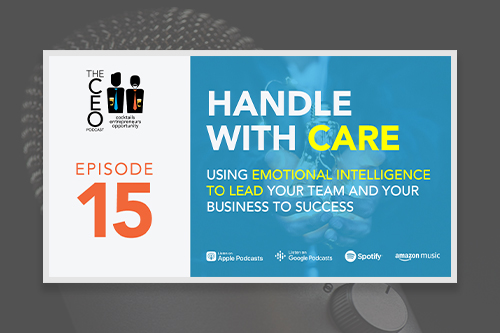Scholars have extensively examined the constructs of trust and trustworthiness throughout the years. They have found that these constructs are vital to establishing good relationships within business organizations. This includes the relationships between the company and its customers, its suppliers, and joint ventures. As you will soon see, two key components of trust are humility and empathy. These traits are critical in developing trustworthiness, and are also essential in today’s business world.
“Trust plays a role in almost all human relationships. It permeates friendship relations, family relations, and economic relations. People rely on the support of their friends, children trust their parents, and sellers trust their buyers to pay the bill.” -Ernst Fehr
Trust is obviously a big part of building and maintaining successful business relationships. This long-form blog explores the essential components of trust, and what it takes to develop trust. These insights will allow you to expand your thought processes on the topic, and apply it to your business or organization. As Kenneth J. Arrow argued,
“Virtually every commercial transaction has in itself an element of trust. . . . It can be plausibly argued that much of the economic backwardness in the world can be explained by the lack of mutual confidence.”
Definition of Trust
There are several definitions of trust in the literature. Perhaps the most frequently cited definition is by Mayer, Davis, and Shchoorman. They state that trust is:
“the willingness to be vulnerable to the actions of another party, based on the expectation that the other will perform a particular action important to the trustor, irrespective of the ability to monitor or control that other party.”
Another definition, offered by Rousseau et al., is that:
“Trust is a psychological state comprising the intention to accept vulnerability based on positive expectations of the intentions, or behavior, of another.”
The concepts of trust have been broken down into two categories:
- Cognitive trust, which revolves around competency, reliability, and calculative assessments; and
- Affective trust, which is relational and intuitive.
Trust can be based on either concept. However, when it is based on both cognitive and affective components, it is more profound and more powerful.
Affective Trust
The feeling that one is respected, supported, and cared for is called affective trust. It is a form of trust that requires an emotional investment between the trustee and the trustor. Therefore, it is developed through emotions built over time, and through personal interactions between individuals.
Crossover Between Cognitive and Affective Trust
The lines between cognitive and affective trust often become blurred. Affective trust is based, in part, on the behaviors of others that lead to an emotional response. Cognitive trust has components described as goodwill or benevolence, both of which can also be a part of affective trust. The difference with cognitive trust is that emotions are based on previous behaviors of the trustee, rather than intrinsic psychological factors.
Cognitive trust may influence affective trust. This is because affective trust is based on the feelings one may have toward another. These feelings, in part, are based on the trustee’s behaviors. The reverse, however, is not true. Affective trust is not a precondition of cognitive trust. For example, cognitive trust can be built based solely on competence and performance measures. In many ways, affective and cognitive trust are related concepts. However, affective trust may be influenced through the behaviors of the trustee, if those behaviors are based on perceptions of benevolence, rather than competency.
Components of Trust
Trust has been divided into three essential components:
- Trustworthiness
- Exhibiting Trusting Behavior
- Distrust
Trustworthiness
Trustworthiness means being worthy of trust given by others. More broadly, trustworthiness has been defined as,
“a belief about the probability of reciprocation based initially on implicit judgments, and then dynamically updated based on experiences.”
Russell Hardin summarized that the trustee has an incentive to be trustworthy. His or her motivation lies in deriving value from creating and maintaining a future relationship. For example, trustworthiness is both beneficial, and necessary, to maintain profitable business relationships.
A moral dimension related to trustworthiness was also noted by Thomas W. Simpson. This moral dimension was somewhat opposed to the previous theory of self-interest. He stated that,
“Some socially important forms of trustworthiness cannot be explained as (merely) instrumentally rational behavior. . . . Character is an alternative explanation for some of the forms of trustworthiness that we actually observe.”
Trusting Behavior
Trusting has been described by Aver and Halldorsson as a spectrum, between completely distrusting and completely trusting. There are a wide range of possibilities between the two ends of that spectrum. Completely trusting would be the willingness of a party to believe a person, or group of people, will cooperate in a way that will fulfill the intent of the act. In contrast, Hill and O’Hara state that trusting others reflects one’s belief that others are not just competent, and have the ability to perform. One must also trust that others are responsible, and possess the intention to perform.
Exhibiting trusting behavior is also an example of being vulnerable to another. The vulnerability suggests an element of one’s ability to accept the risks of trusting others. According to Catherine Eckel and Rick Wilson, vulnerability is contrasted with risk aversion. They feel that vulnerability will only become visible after trust is established.
Some argue that mitigation of inherent risk is used as a protective measure. William Watson noted that this trust but verify approach was popularized by President Ronald Regan when dealing with the Soviet Union and disarmament in the late 1980s. In this model, the trustor provides the trustee with room to operate. The trustor will then verify that the work has been done, or that the commitment, or promise, has been kept.
Distrust
Schoorman, Mayer, and Davis suggested a contrary point of view. They suggest that the act of verifying, by its nature, shows a level of distrust. The act of checking-up on the trustee suggests that the trustor may not believe the commitment will be upheld. The act of verifying, therefore, demonstrates a Distrust.
Lewicki, et al. characterize distrust as the belief that others’ intentions are in opposition to one’s best interests. In fact, they may even act in direct opposition, causing harm to one’s interests. In other words, distrust is often viewed as the opposite of trust. Distrust in others is characterized by several factors, including: fear, skepticism, cynicism, wariness, watchfulness, and vigilance.
The construct of distrust is associated with a low propensity to trust. There are also conditional factors associated with distrust. Roderick Kramer cites seeing others as belonging to a group outside their own can be a condition of distrust. Furthermore, the influence of a third party, in the form of gossip, can also cause distrust. Distrust is also a condition that can be earned. For example, distrust is immediate when another person breaks an actual, or social, contract.
Propensity to Trust
Anthony Evans and William Revelle suggested an attitude of trust is based, in part, on the personality of an individual. Individuals with a propensity to trust are consistently described as having the personality traits of openness and vulnerability. These traits are enduring, and not easily influenced.
The propensity to trust has been described as one of the components of trust. One study describes the propensity to trust as a necessary component for building trust quickly, or what is called swift trust. Some individuals in the study exhibited a high propensity to trust others. This propensity allowed for a quicker acceptance of the vulnerability that is inherent in trusting relationships.
One advantage for those with a high propensity to trust is the ability to create ad-hoc teams effectively in business. A crisis management situation is an example of when an ad-hoc team would be useful, because the time to form and make crucial decisions is limited. A high propensity to trust can also have disadvantages. In life and in business, trust can be taken advantage of. Harm can be created in situations where there is a willingness to trust others without first experiencing demonstrable traits of trustworthiness.
Therefore, there are more risks for those who possess a high propensity to trust. This is because they may be more willing to take risks based on unverified factors. Lewicki et al. theorized that a low propensity to trust might actually be a positive trait. For example, in team development, it may reduce the risk of groupthink in that team.
Psychological Propensity Theory
There are conflicting theories of how individuals develop their propensity to trust, or not to trust. Laurie Couch and Warren Jones found that the propensity to trust others may be an innate psychological trait, or a trait acquired through early childhood experiences.
They found that one’s trustworthiness is influenced by the extent to which their propensity to trust is high or low. Psychological propensity theory explains that the desire, or willingness, to trust is either developed biologically, or in the early childhood development process. This propensity to trust is unwavering throughout life, regardless of experiences.
Social-Learning Perspective
A contrasting view of the psychological propensity theory is that of the social-learning perspective. From this perspective, the propensity to trust stems from social learning. Lois Stack asserted that people generalize about others based on their experiences of how other people have treated them. The social-learning perspective demonstrates an evolutionary process. During this process, events throughout one’s life influence one’s propensity to trust.
Jennifer Glanville and Pamela Paxton also studied the social-learning perspective. They posited that high trust could produce a greater degree of generalized trust. Generalized trust is a construct closely related to the propensity to trust. The social learning perspective can also clarify a low propensity to trust. High trust can develop into low trust when trustworthiness is challenged by untrustworthy behaviors. This situation would then lead to distrust.
Characteristics of the Components of Trust
Components are elements of a larger whole. Those components possess specific characteristics that are features, or qualities, of those components. The attributes of trustworthiness, and exhibition of trusting behaviors, consist of: (a) humility, (b) empathy, and (c) vulnerability. We will discuss the first two concepts in Part 1 of this long-form blog, and discuss vulnerability in Part 2 of the blog.
Humility
Scholars have struggled to develop a definitive definition of humility. It might be easier to describe terms not associated with humility, such as arrogance, pride, or self-importance. However, Davis, et al. explain that, “the absence of something negative does not necessarily imply the presence of something positive.”
Modesty, or open-mindedness, are often described as humility. These terms may represent some of the characteristics of a humble person. Within the context of the communication process, characteristics of humility include:
- Orientation to others in one’s relationships with others, rather than selfishness
- The tendency to express positive other-orientated emotions in one’s relationships (e.g., empathy, compassion, sympathy, and love)
- The ability to regulate self-oriented emotions, such as pride and excitement about one’s accomplishments in socially acceptable ways
- Having an accurate view of self
Humility can be described as an accurate and realistic view of self-knowledge, and the communication of that knowledge with others. It is often viewed as a crucial component in trustworthiness according to Nielsen, Marrone, and Slay. Humility can manifest in several ways, such as the ability to be open to new paradigms, and the ability to ask for advice. Eagerness to learn from others, and acknowledgment of one’s mistakes and limitations are also characteristics of humility. These traits are key to business relationships, and are necessary for team members to well work together.
Displaying humility also enables one to become trusted by others. High humility in the trustee allows the trustor to have a greater sense that an unknown trustee is trustworthy. This is because the display of humility garners trust efficacy.
Empathy
Empathy has been defined in the literature as the ability to understand another’s motives, values, and emotions. Daniel Goleman expanded this definition by offering three types of empathy:
- Cognitive
- Emotional
- Empathic Concern
Cognitive Empathy
The ability to understand the world from another’s point-of-view. This form of empathy informs individuals of how they can communicate effectively with someone.
Emotional Empathy
Empathy is described as developing an understanding of how another person is feeling. Stephen Covey emphasized emotional empathy in describing a style of listening, termed empathic listening. Covey described empathic listening as listening to understand, as opposed to listening to reply. Emotional empathy allows individuals to make deeper connections with individuals. Empathetic listening allows others to recognize that they are being heard and understood.
Typically, this form of empathy requires senses other than the audible. For example, reading facial clues and other body language can assist with empathy and understanding. Emotional empathy is a powerful tool in building trust, especially in business. Covey says that trust is built through empathic listening. This is because one person has shown an interest in another, and what the other is saying.
Empathic Concern
This type of empathy is more profound than cognitive or emotional empathy. It is the type of empathy that relates to a parents’ love for their children. This form of care is at the heart-level of human emotion. In the context of a working and business relationships, empathic concern allows others to know that they will receive support. While all three types of empathy can aid in the ability to communicate, Goleman believes that emotional empathy provides the most significant impact on the development of trust. To display empathy also requires one to be vulnerable. Garner stated that,
“To be with another in this way means for that the time being, you lay aside your views and values to enter another’s world without prejudice.”
Conclusion
So far, this blog has covered the definition of trust, and its main components and characteristics. In Part 2 of this blog we will dive into the third characteristic of trust, which is vulnerability. We will also look at the conditions necessary for trust, and the process of trust development.
As you read through parts 1 and 2 of this blog, it may help to think about your organization or business. Consider areas where you may need to work on forming more trusting relationships. Perhaps you have seen conflicts arise lately, and your business could benefit from some work in the areas of listening to understand, humility, empathy, or emotional intelligence. All of these areas contribute to increasing trust within your organization, and we can facilitate in this process if you need help.
This blog is based off of a longer piece of work with full citations. If you would like to read the original work, please contact us for more information.




Comments 1